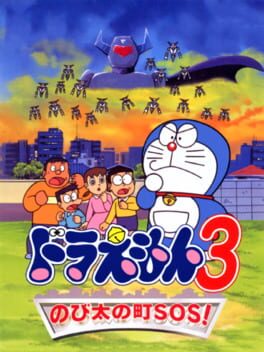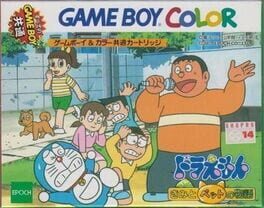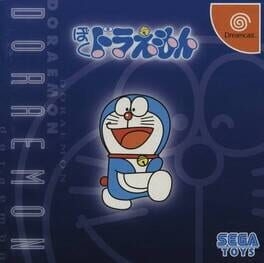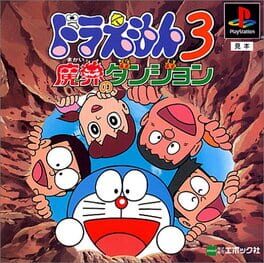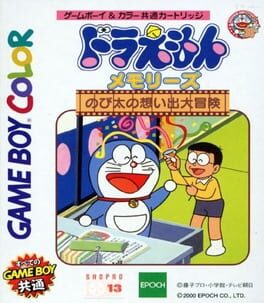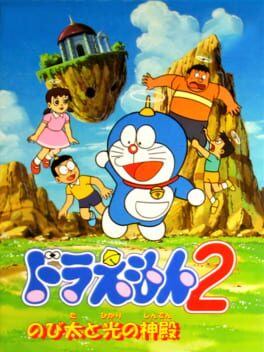

Doraemon 3: Nobita no Machi SOS! is an action game for the Nintendo 64. It was released only in Japan in 2000. The game is based on the Japanese manga Doraemon and has is the sequel to two N64 games, Doraemon: Nobita to Mittsu no Seireiseki and Doraemon 2: Nobita to Hikari no Shinden, all only released in Japan.
Also in series
Reviews View More
The last of the N64 Doraemon trilogy, and coming to us all the way in the year 2000, so ends my journey through these oddball region-exclusive hidden gems. Coming out in '97, '98, and 2000, the trilogy, despite the varied genres at play, give a pretty neat view of what the N64 could do at a glance as devs figured out how to use it more and more. This one was twice the price of the others when I bought it, so I did go in expecting a bit more than the others, and that's more or less what I got. It took me about six or so hours to do just about everything in the game on hard mode, and I only had to look up one or two things.
The game opens with Nobita being annoyed with doing his summer homework. He complains to Doraemon when suddenly a meteorite explodes in the sky outside. When Nobita goes outside to investigate, he finds his three friends have found the shards of the meteorite, but when put back together, they start a chain reaction that lifts up the block that Nobita lives on, and takes the whole thing into space faaaar away to the planet Duct. With his friends spirited away to who knows where and the town under attack by evil robots, Nobita goes to find Doraemon, only to find him passed out in his room. Everyone in town has been captured in time-space slime, freezing them in place, but Doraemon has partially escaped this fate. While Doraemon himself (and his trusty impact pistol) have escaped being frozen, all the tools in Doraemon's pocket are slimed and unusable! You embark on a mission to save your town and the rest of the citizens of Duct who've also been kidnapped and taken here. The story is a little more involved than the past two games, and it does lend itself to being a little more of an adventure game than the previous ones, but not by a tooooon. It does what it needs to, and also gives you a sense of progression as you go from level to level and area to area.
This is an adventure/action platformer that is in many ways a blend of the first and second games in the trilogy. You go from stage to stage hunting for necessary mcguffins you'll need to access the dungeon at the end of the area, and in that dungeon you'll face a boss to rescue one of your captured friends. You once again have different playable characters (with even Doraemon's little sister eventually joining the fray), and at last their different characteristics (different swimming/running speeds and jumping heights) are explicitly told to you on the character selecting screens. Each one even has their own health bars that need to be healed independently. The gameplay is a mix of some behind-the-shoulder platforming stages (more like Banjo-Kazooie) and fixed camera platforming stages (more like Bomberman Hero), and while it's never particularly difficult, it's a fine test of action and platforming, especially for someone who might not be super experienced in this genre.
However, the refocused story elements and gameplay loop changes somewhat hurt the game mechanically more than anything. As, even though it's nice in a sense to have Doraemon's tools not be lost for once, the way you get them back is by collecting this slime-destroying spray to de-slime them. However, you can grind for the spray if you want, so you can get all of your tools and weapons at the very start of the game if you want. Like in the second game, you do use tools to solve puzzles, but the game just tells you when to use the stuff for the puzzles. While this is a nice feature so you aren't just guessing forever on what tools solve what environmental puzzles, it very much does reek of "the game giving you a solution to a problem it has created itself".
Not even needing to find tools means that exploration isn't so absolutely necessary as in the first two games, but it also means you're just never finding anything interesting by exploring other than more already super abundant healing items (which you can carry tons and tons of, so the game is never super difficult). Healing items being so abundant also means that each character having their own health bar doesn't really encourage switching between them very much, since you always have an over abundant supply of health. These aren't experience breaking problems, but they are an unfortunate drag on the gameplay loop despite how solid the first two games were in that regard.
The presentation is what the trilogy has led us to expect at this point, combined with where N64 development was by 2000. All of the character models have gotten significant upgrades and have a pastel-y, nice Mega Man Legends style to them. There are a lot more animations, and while it isn't exactly Banjo-Tooie in terms of just how flashy it is, it's a very nice looking N64 game. The music is also, once again, pretty darn good, with the boss themes especially being really good.
Verdict: Recommended. I still think the first game in the series is probably my favorite, but this is a much needed mechanical improvement on the second game. It's still got some fundamental design issues that make it feel a bit unrewarding to play in some regards, but it's still a fun time! It's definitely not a great import, as it's got some even more involved adventure/questing aspects than the second game did that require reading, but for those who can get past the language barrier, this is another nice hidden gem on the N64.
The game opens with Nobita being annoyed with doing his summer homework. He complains to Doraemon when suddenly a meteorite explodes in the sky outside. When Nobita goes outside to investigate, he finds his three friends have found the shards of the meteorite, but when put back together, they start a chain reaction that lifts up the block that Nobita lives on, and takes the whole thing into space faaaar away to the planet Duct. With his friends spirited away to who knows where and the town under attack by evil robots, Nobita goes to find Doraemon, only to find him passed out in his room. Everyone in town has been captured in time-space slime, freezing them in place, but Doraemon has partially escaped this fate. While Doraemon himself (and his trusty impact pistol) have escaped being frozen, all the tools in Doraemon's pocket are slimed and unusable! You embark on a mission to save your town and the rest of the citizens of Duct who've also been kidnapped and taken here. The story is a little more involved than the past two games, and it does lend itself to being a little more of an adventure game than the previous ones, but not by a tooooon. It does what it needs to, and also gives you a sense of progression as you go from level to level and area to area.
This is an adventure/action platformer that is in many ways a blend of the first and second games in the trilogy. You go from stage to stage hunting for necessary mcguffins you'll need to access the dungeon at the end of the area, and in that dungeon you'll face a boss to rescue one of your captured friends. You once again have different playable characters (with even Doraemon's little sister eventually joining the fray), and at last their different characteristics (different swimming/running speeds and jumping heights) are explicitly told to you on the character selecting screens. Each one even has their own health bars that need to be healed independently. The gameplay is a mix of some behind-the-shoulder platforming stages (more like Banjo-Kazooie) and fixed camera platforming stages (more like Bomberman Hero), and while it's never particularly difficult, it's a fine test of action and platforming, especially for someone who might not be super experienced in this genre.
However, the refocused story elements and gameplay loop changes somewhat hurt the game mechanically more than anything. As, even though it's nice in a sense to have Doraemon's tools not be lost for once, the way you get them back is by collecting this slime-destroying spray to de-slime them. However, you can grind for the spray if you want, so you can get all of your tools and weapons at the very start of the game if you want. Like in the second game, you do use tools to solve puzzles, but the game just tells you when to use the stuff for the puzzles. While this is a nice feature so you aren't just guessing forever on what tools solve what environmental puzzles, it very much does reek of "the game giving you a solution to a problem it has created itself".
Not even needing to find tools means that exploration isn't so absolutely necessary as in the first two games, but it also means you're just never finding anything interesting by exploring other than more already super abundant healing items (which you can carry tons and tons of, so the game is never super difficult). Healing items being so abundant also means that each character having their own health bar doesn't really encourage switching between them very much, since you always have an over abundant supply of health. These aren't experience breaking problems, but they are an unfortunate drag on the gameplay loop despite how solid the first two games were in that regard.
The presentation is what the trilogy has led us to expect at this point, combined with where N64 development was by 2000. All of the character models have gotten significant upgrades and have a pastel-y, nice Mega Man Legends style to them. There are a lot more animations, and while it isn't exactly Banjo-Tooie in terms of just how flashy it is, it's a very nice looking N64 game. The music is also, once again, pretty darn good, with the boss themes especially being really good.
Verdict: Recommended. I still think the first game in the series is probably my favorite, but this is a much needed mechanical improvement on the second game. It's still got some fundamental design issues that make it feel a bit unrewarding to play in some regards, but it's still a fun time! It's definitely not a great import, as it's got some even more involved adventure/questing aspects than the second game did that require reading, but for those who can get past the language barrier, this is another nice hidden gem on the N64.
